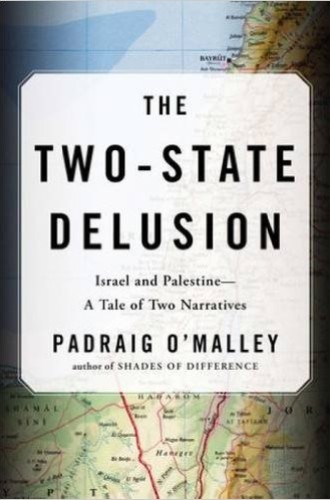The Two-State Delusion, by Padraig O’Malley
The obituary for the two-state solution to the Israeli-Palestinian conflict has been written multiple times over the past two decades. From the moment the Oslo Accords were signed, observers have warned that the geographical basis for a two-state solution is being eroded by the construction of Israeli settlements, road networks, walls, buffer zones, electrified fences, and more. Yet Palestinian, Israeli, and other political leaders continue to affirm that a two-state solution is the only game in town.
At times rhetorical commitment to the two-state solution has slipped, as it did in the days preceding the March 2015 Israeli parliamentary elections, when Prime Minister Benjamin Netanyahu, in a bid to prevent voters from abandoning his center-right Likud party for parties still further to the right, pledged that his government would not permit the creation of a Palestinian state. Yet since his reelection Netanyahu has returned to the rhetoric of a two-state solution, even as his government strengthens the settlement enterprise that renders such a solution unworkable.
Read our latest issue or browse back issues.
In The Two-State Delusion, Padraig O’Malley, professor of peace and reconciliation at the University of Massachusetts, has penned a deeply skeptical study about the possibility of a two-state solution. O’Malley has extensive experience in the study of peace-building processes in Northern Ireland and South Africa and has now turned his attention to another purportedly intractable conflict.
O’Malley is by no means the first scholar to suggest that the two-state approach represents a failed paradigm: scholars such as Tony Judt, Virginia Tilley, and Edward Said have advanced similar claims. Yet whereas most critics of the two-state approach suggest some other paradigm to replace it—a struggle for equal rights within one state for Israeli Jews and Palestinians; some form of binational confederation; a vision of parallel, overlapping states—O’Malley remains in the deconstructing stage.
O’Malley examines many different aspects of the conflict: the fate of Palestinian refugees; the radically asymmetrical economic arrangements between Israel and the occupied territories; inequitable access to water resources; the relentless construction of settlements; the status of Jerusalem; the so-called demographic problem facing Israel, in which Israeli Jews will soon become a minority within the land over which Israel exercises sovereign control; and more. His takeaway from this exhaustive examination is skepticism about the future of the two-state solution, and palpable dismay—disgust might not be too strong a word—at what he views as the captivity by Israelis and Palestinians in their own narratives and in the hatred for the other that such narratives breed.
By the end of the book, what little hope O’Malley expresses is based on the prospect of Israelis and Palestinians coming to respect each other’s narratives over time. This view seems odd given the many chapters outlining the material ways in which the Israeli settlement project has left Palestinians enclosed within ever more restricted islands of territory and has thus rendered a two-state solution unworkable. Even odder is how little space O’Malley devotes to thinking beyond the two-state solution. He pays scant attention to the Palestinians, including Palestinian Christians, and Israeli Jews who are working to forge new paradigms.
Antonio Gramsci famously wrote that pessimism of the intellect should be joined to optimism of the will. O’Malley has pessimism about the two-state solution down cold. Some optimism, however tenuous, regarding paradigms that might replace that solution is sorely missing.






